Rhubarb is an easy to grow perennial that deserves a spot in your temperate garden. Do you have a patch of this tart perennial vegetable on your homestead? Plant it now and enjoy the harvest for decades.
Rhubarb is one of those plants that every homestead in Canada has, planted in a back corner. You rarely find it at the farmer’s market or grocery store because everyone has it growing in the garden. Rhubarb was also called “Pie-Plant” because it was used to make pies. If you don’t have it growing in your garden yet, your neighbor probably does and will gladly trade you a plant division in the spring. If you want a special variety, garden centers in zones 2 to 8, have rhubarb starts in spring.
Rhubarb is a hardy perennial that will grow in the most difficult circumstances. It doesn’t mind frost. It is hardy to -50F. It is one of the first plants to show signs of life in the spring. It is so hardy that we will often find it already growing when the snow melts. I have had rhubarb still producing after 70 years. We brought a piece of the root from that 70 year old rhubarb plant at our old acreage to our new homestead 20 years ago and it is still producing and thriving.
Plant it in well-draining soil. It won’t thrive in standing water.
All children are told never to eat the rhubarb leaves because they are poisonous. Rhubarb leaves contain poisonous substances, including oxalic acid, which is a nephrotoxic and corrosive acid that is present in many plants. Russian settlers in my area added rhubarb leaves to their spring borscht, by first cooking the leaves in boiling water and discarding the water, before adding the leaves to the borscht pot. This removes much of the oxalic acid and renders the leaves safe for eating, in small amounts. But even then I don’t recommend consuming rhubarb leaves.
During World War I, the leaves of rhubarb were mistakenly recommended as a food source in Britain and many people were poisoned after ingesting the leaves, so we don’t recommend you eat them at all. You can safely compost them or try one of these other creative methods for using rhubarb leaves from Learning and Yearning.
Many animals, including my goats and llamas, will eat rhubarb leaves in the spring while leaving the acidic stalks. Since they only do this occasionally, I assume the leaves offer medicinal benefits to them. Perhaps rhubarb leaves help with spring deworming.
Propagating rhubarb
Rhubarb grows in zone 2 to 8. It requires an extended chilling period below 40 degrees F, in order to produce stems after winter. It can be grown as an annual from seed in zones 9 and 10, but the stalks will be smaller and less robust. Plant rhubarb in full sun to part shade. But the colder your spring, the better it will do in full sun. If you live where it’s very hot in summer, it will produce longer in the season in part shade.
Most garden rhubarb are clones of rhubarb varieties that were grown commercially for many years. These plants are divided from the mother plant or cloned through tissue culture. Plant the crowns during the dormant season leaving 18 to 30 inches between plants. The crown should be planted at soil level with the roots spread out in the planting hole. Top dress with 3 to 4 inches of compost or plenty of well-rotted manure to add organic matter to the rhubarb bed. Mulch the bed with straw or wood chips to keep out perennial weeds in the early spring and to encourage fungal dominance in the soil, which improves the health of the plants.
Rhubarb dies back to the ground in winter (winter dormancy) and comes up fresh each spring from the crown.

Growing Rhubarb from Seed
Rhubarb sends up a flowering stalk in late spring. Each plant will send up several stalks that form in the middle of the plant. You’ll recognize these as they have a white sheath over the flowering head. When the plant sends its energy into the flowering stalk, the production of side stalks slows down. If you don’t want seeds, you need to remove these flower stalks when you see them, by twisting them from the plant at their base. They will bring some thin rhubarb petioles with them and the plant will continue to produce more stalks.
If you want rhubarb seed, leave the flowers on the plants to bloom. They are bee pollinated and will produce seeds by the end of the summer. Gather the seeds when they are dry and keep them in a paper bag to fully dry before storage. A new rhubarb plant will grow from the seeds but they will not be like the parent plant. You might get a brand new variety of rhubarb.
If you let your plants produce seed, you may find volunteer rhubarb plants growing close to your rhubarb patch. Transplant these new plants to an area of full sun. Don’t harvest from them in the first year at all. In the second year you can harvest one or two stalks but leave the majority of the stocks to feed the roots. In the third year you’ll be able to harvest from these seedlings. They will be in full production by year 4.
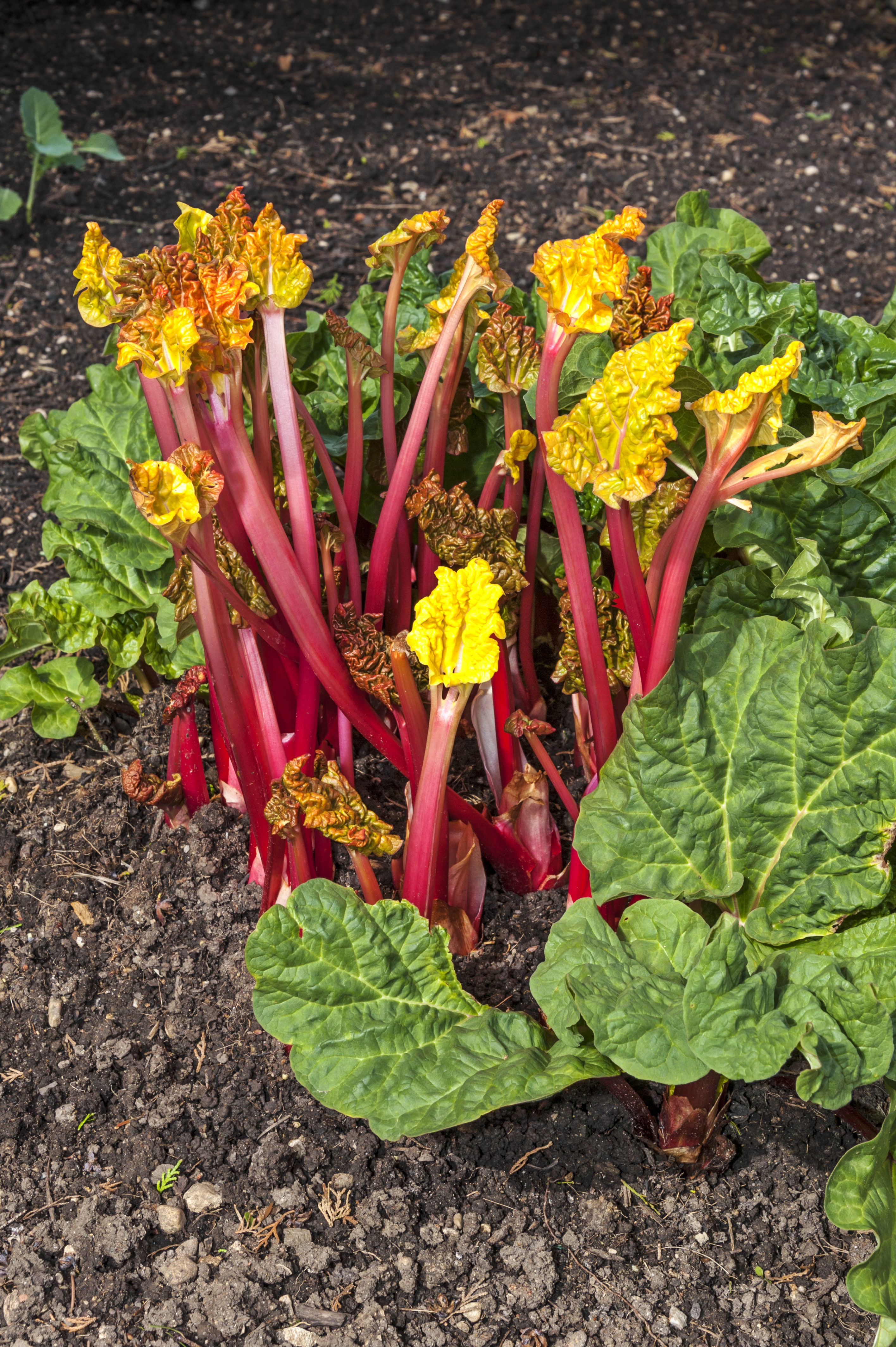
A crop of rhubarb that has been ‘forced’ (made to grow tall, early in the season, by shielding from light)
Forcing Rhubarb
Plants in their third year or older can be forced to produce the earliest spring rhubarb. Forced rhubarb is tender and sweeter than conventionally grown rhubarb. The stalks and leaves are pale from lack of light. The stalks or petioles grow long and straight searching for the light. They are harvested when the top of the stalk reaches the top of the container. However, forcing can compromise future growth, so choose plants that are at least 3 years old and do not force the same rhubarb plant two years in a row, so that it can recover from the stress.
Decorative rhubarb forcers are available at some garden stores but they are unnecessary. A tall plant pot, a deep wash tub, a 5 gallon plastic bucket, or other container that is at least 12 inches deep can be used successfully to force rhubarb. The rhubarb, in this warmer microclimate, sends up its stalks earlier and they are blanched by the darkness. The shoots stretch toward the light and are more tender and sweeter. Forced rhubarb can grow an inch a day so check on the rhubarb after 3 or 4 weeks and harvest it when it reaches the top of your forcing pot.

Rhubarb Cultivars
There are several common varieties of rhubarb available to the home gardener.
Canadian Rhubarb has green stems with just a hint of red. These stems will remain green even when ripe. The plant is common on Canadian homesteads.
Strawberry rhubarb, on the other hand, gets its name from the red stems. This rhubarb has a pink tinge when cooked down. The flavor is similar to Canadian Rhubarb but the color is definitely a warm red that extends deep into the petiole, even when young.
Canada Red is a super hardy rhubarb, developed in Winnipeg, Manitoba. It has large, juicy red stalks with a hint of sweetness. It will give your rhubarb pie or rhubarb sauce a lovely red tinge.
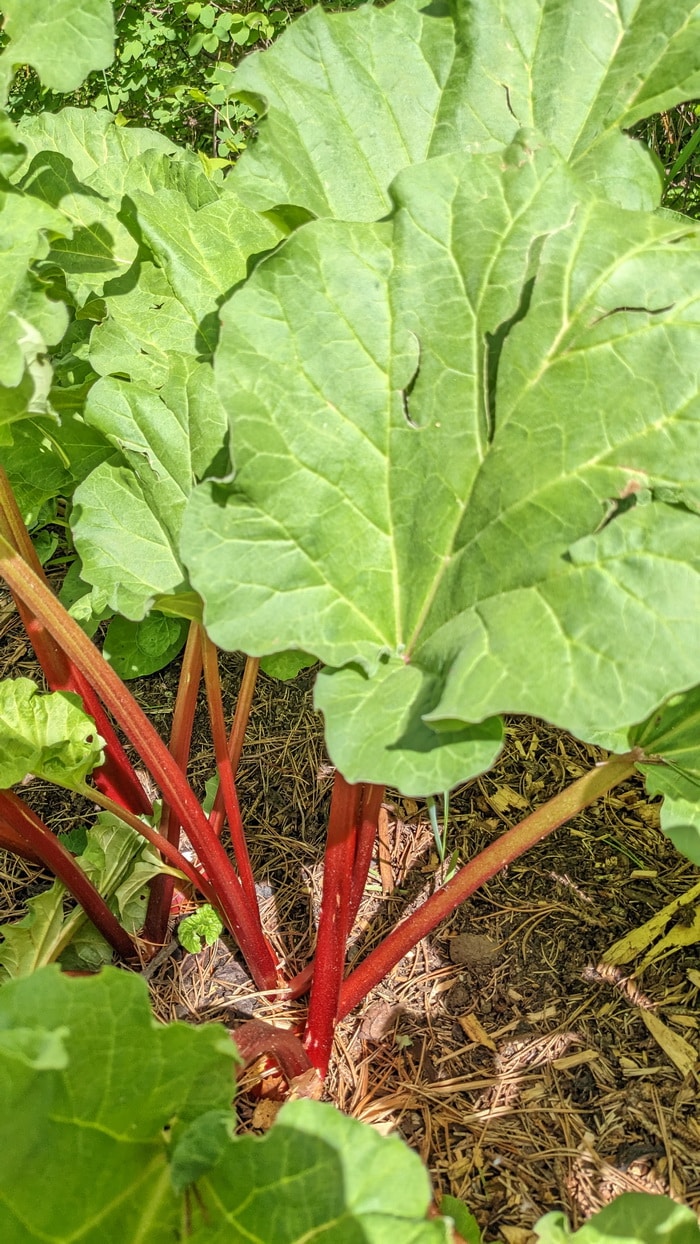
Canada Red rhubarb
Crimson Red loves the rain and is a great variety to grow where winters are wet and cold, like in the Pacific Northwest, though it will also thrive in colder areas. This variety gives a lovely red tinge to rhubarb sauce. It is one of the sweeter varieties when ripe.
German Wine is a hybrid (R. x coltorum) that was bred for juicy stalks. It has a 3 foot spread and, for me, produces stalks right into August, about a month later than Canada Red. It has good heat tolerance and slightly less puckery flavor. The stalks are green with red to pink on the base of the stems. The flavor of German wine is sweeter than other rhubarbs. It is useful for processing and fresh eating. With the juicy stalks it is the best variety to use for rhubarb shrub.
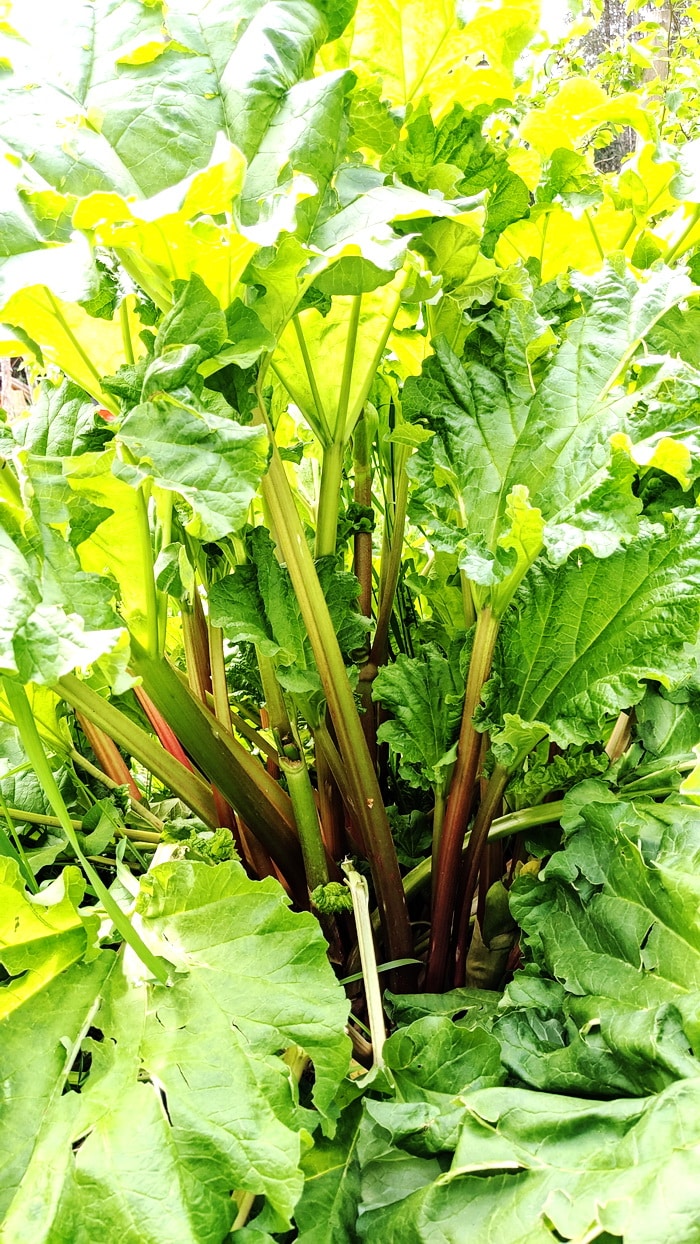
German Wine Rhubarb
Crimson Cherry, like the name implies is sweeter than many other rhubarb varieties, with attractive red stalks.
Victoria is one of the oldest rhubarb varieties, introduced in 1837 in Britain in honor of Queen Victoria. A green-stalked cultivar, it was one of the first rhubarbs with red blush on the stalks. Prior to its introduction most rhubarbs in use had yellow or green stalks. It is credited with introducing rhubarb into British and American kitchens over 185 years ago. It is still grown today and might be found around the world in the back corner of abandoned farms and homesteads in Britain and Canada.

Victoria Rhubarb
Harvesting Rhubarb
Rhubarb doesn’t ripen like other fruit, so there is no change in color when it is ready to eat. If you plant strawberry rhubarb, the stems will be red. If you plant Victoria rhubarb, your stems will be green, with a red blush. If you plant German Wine the stems will be pink with a green tinge.
Rhubarb is ready to harvest when the stalks are about 18 to 24 inches long and at least an inch thick, and firm. In my zone 3 that’s about a month from snowmelt, for your first harvest.
If you are planting a new bed of rhubarb on your homestead, try to get plants from a neighbor rather than planting garden nursery plants. The plants already growing in your neighborhood will be acclimatized to your region and have more vitality than nursery plants that are shipped over many miles. Take root divisions in early spring or late fall from 3 to 4-year-old plants, when they are just beginning to emerge or after harvest. There should be as little vegetation on the plant as possible.
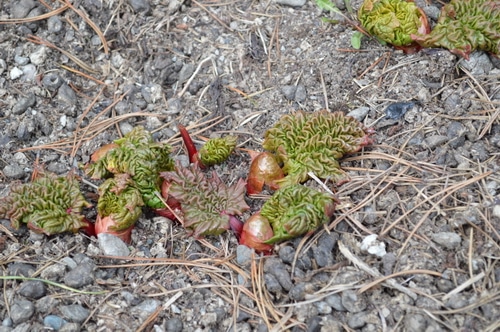
Rhubarb benefits from annual top dressing with composted manure or other compost. It’s a heavy feeder and grows really well when given a second application of composted manure when you are done harvesting for the season.
Bringing a neglected rhubarb back
Let’s talk about how to bring a rhubarb plant back that’s been neglected. After many years of growth, a rhubarb plant needs to be divided. The root grows woody in the center and the tender stalks grow around the circumference of the root. The harvest seems huge but renewing the plant with some extra attention will help it improve.
Divide the plant in early spring or late fall, by cutting through the root with a sharp, clean shovel. I like to slice off the sides of the root while leaving the original root intact. This way I will get a harvest from the original plant, while allowing the new root divisions to take hold, in another location. Take 4-inch pieces of root with a bud attached. You want some growth buds or stalks attached to the root portion that you are taking away from the main plant.
Prepare a New Rhubarb Bed
Prepare a new rhubarb bed by tilling the soil well and amending with an inch or two of well-composted manure. Dig a hole and plant the root division to the same depth as the original plant. Firm the roots in well and water thoroughly. Mulch with clean straw to keep down weeds and conserve moisture.
You can plant rhubarb plants 18 inches apart in a row with enough room between plants to allow you to walk between rows to weed. If you are planting in a raised bed, plant them on 18-inch centers to allow the plants to spread. You will be getting to weeds from the sides of a raised bed so you don’t need room to walk between the rows.
In the first year that you plant a new rhubarb bed, don’t harvest any stalks. You can start harvesting rhubarb in the second season from planting.

How to harvest rhubarb stalks
To harvest rhubarb, grasp the stalk at the base of the plant and pull up or twist the stalk at the base to pull it from the crown. Do not cut the stalks from the plant, but instead pull them out of the crown. This will leave behind a sheath and the stalk will pop out from the root. I like to break off the leaves from the stalk, as I’m harvesting, and lay them out in the garden under the plants to provide mulch. You’ll find that rhubarb leaves act as a wonderful mulch and inhibit weeds.
To keep your plant thriving, only harvest ½ to 2/3rds of the longest and thickest stalks at a time. New stalks will grow from the root and the stalks you have left will grow thicker and longer. Harvesting allows more sunlight to reach the roots, which encourages new growth.

Flowering stalk emerging from the center of a rhubarb plant in late May
The flower stalk looks different than the fruit stalk on a rhubarb plant. You may find a flower stalk coming up in late May to mid-June from your root, or if the plant gets stressed from lack of water during the growing season. Break this off if you intend to continue harvesting your plants.
Never take more than 2/3rds of the stalks from your plants at any one harvest, and allow new stalks to grow before harvesting again.
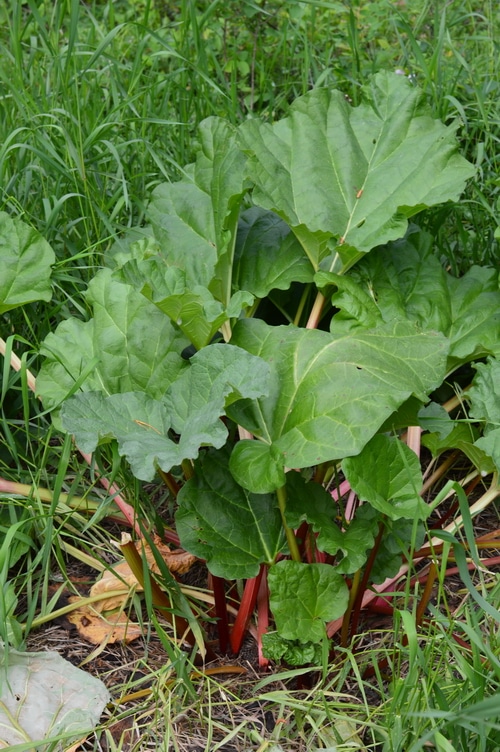
Around midsummer, or if the plants get water stressed, rhubarb plants will stop growing new stalks. The stalks will be thin and feel limp and hollow. This last harvest period varies depending on where you live and the variety of rhubarb you are growing. At Joybilee Farm, in zone 3, I get my last harvest of rhubarb in the middle of July. When you see that your rhubarb stalks are getting thin and limp, stop harvesting for the season. The remaining stocks that the plant has will be needed to feed the root for next year’s harvest. The plants benefit from mulch for the second time with well-composted manure, and leave the plants to grow naturally for the rest of the season. They do require watering if you are in a drought, to keep the leaves green and feeding the root. The plant will pay you back with an abundant harvest in the following year.
Growing rhubarb seeds
A rhubarb plant that sends up a flower stalk will produce viable seeds. Rhubarb plants will cross-pollinate with other rhubarb plants in the same area. So if you are growing more than one kind of rhubarb and both varieties of rhubarb flower, you may have some cross-pollination. The seeds that come from flowering rhubarb are viable and will grow more rhubarb plants. Let the seeds dry on the stalk until frost. Cut off the seed stalk and place in a paper bag to finish drying indoors. Then rub the seeds from the stalk when completely dry.
Plant the seeds in the spring and see what grows. You might come up with a brand new rhubarb variety. Always taste the stalks from a new planting from seeds, to see if you like what comes up. Your best plants can be cloned after year 3 to produce new rhubarb plants. (clonal reproduction).
When growing rhubarb from seed in zone 2 to 8, leave the first year plants to develop a strong root system. You can harvest stalks from the plants the following year. By year three, in fertile soil, your plants will be robust and you’ll be able to clone them for more rhubarb plants.
After the Harvest – What to do with Rhubarb

When you harvest the stalks wash them right away and be sure to keep them from drying out until you can process them. Cut off the tough part at the base of the stalk and the part where the leaf was attached. They are tart and juicy and many people like to eat them fresh, dipped in sugar. That’s a bit too much tartness for me.
There are four basic ways to preserve rhubarb.
- Freeze them. Cut them into sections (like the above picture). According to the National Center for Home Food Preservation, blanching rhubarb in boiling water for one minute, and cooling promptly in cold water helps retain color and flavor. It is, however, not necessary to blanch rhubarb. Lay the pieces on cookie trays and freeze until solid. When they are completely frozen, transfer them to plastic bags so you can use them in small or large batches.
- Make stewed rhubarb by canning them.
- Ferment them. Try our Fermented rhubarb pickles recipe.
- Turn them into a recipe like jam, sauce, or pie. Or try these recipes for starters:
Oxalic acid warning:
Oxalic acid is a plant secondary metabolite that can cause illness in some people, when eaten in large amounts. The body doesn’t have a path to easily clear oxalic acid and it can be stored in organs, joints, and muscle tissue. While one serving of oxalic acid heavy food shouldn’t be harmful, excess amounts can cause kidney stones, arthritis, skin rashes, and other discomfort. Rhubarb, spinach, beet greens, sorrel, are some of the foods that are high in oxalic acid. Please do your own research.




I need to re-start rhubarb at my place, due to illness the plants got dried out and choked out by comfrey growing in the same area
I’ll be looking for root divisions through my local online market
What are your thoughts about growing rhubarb and asparagus together?